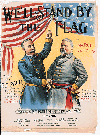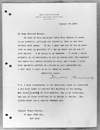
PART II: PUBLIC APPEALS, 1898
8. THE MAINE AS BATTLE CRY AND PUBLICITY
The interaction of pro-war propaganda and public sentiment in the United States reached its highest pitch when news of the Maine explosion was prominently featured in sensationalist newspapers. Cartoonists and composers created imaginative renderings of the explosion and its purported causes. As one song put it: "Our noble ship lay anchored within Havana's bay, the next morning over the country the news flash'd far and wide, of how the murd'rous Spaniards destroyed the navy's pride. Sailors were in slumber, no dreams of war had they . . ." ("Remember the Maine: Song and Chorus" by Horace Basler and Jesse Sopher, 1898). An enraged public had now come to favor war with Spain. To the perception of inhumane Spanish rule in Cuba was added that of Spain as a treacherous enemy, an unproven view privately shared by Theodore Roosevelt. Traces of this popular mood are preserved in war songs, poems, and such diverse media as an engraving reading "To hell with Spain, Remember the Pain, J.D. Rose, Aug. 10, 1898," found on the interior of the bell in the tower of The New York Public Library’s Jefferson Market branch in Greenwich Village.
Exhibition Checklist
9. THE PROPAGANDA POWER
OF CARTOONS
 During the nineteenth century, cartoons were exploited by talented
artists and publishers as a means to satirize and criticize political affairs
in seminal publications such as Puck and Judge. By the end of
the century, the suggestive power of cartoons, especially among a growing popular
readership, was prominently utilized by the new sensationalist press as a way
to increase circulation.
During the nineteenth century, cartoons were exploited by talented
artists and publishers as a means to satirize and criticize political affairs
in seminal publications such as Puck and Judge. By the end of
the century, the suggestive power of cartoons, especially among a growing popular
readership, was prominently utilized by the new sensationalist press as a way
to increase circulation.
 Improved
color and new printing techniques in the magazine and newspaper industry enhanced
the iconographic power of cartoons precisely at the time of the 1898 patriotic
upheaval. The talent, technology, and resources developed in the immediately
preceding years were focused to mobilize public sentiment and opinion.
Improved
color and new printing techniques in the magazine and newspaper industry enhanced
the iconographic power of cartoons precisely at the time of the 1898 patriotic
upheaval. The talent, technology, and resources developed in the immediately
preceding years were focused to mobilize public sentiment and opinion.
10. JOURNALISTS AND REPORTERS
The new style of journalism of the 1890s, competing in content and format
to attract newspaper readers in the United States, required and promoted a new
kind of journalist. Intrepid young reporters provided the raw material, even
creating news if needed, for popular press campaigns, true crusades, and stunts
that amused and moved readers. The more daring or accomplished reporters were
sent to cover news abroad, especially conflicts and wars. In particular, the
separatist war in Cuba proved to be a foreign topic of unprecedented public
interest. Before and during the Spanish-American War, correspondents displayed
provocative, sensationalist traits that often resulted in scandal, flagrant
inaccuracies, and problems with Spanish and U.S. authorities. The hazards they
encountered abroad were also the focus of press campaigns in the United States.
They competed and debated with each other to become celebrities. Their accounts
have colored the memory of the war to an extent perhaps never repeated in news
coverage of subsequent wars.
11. AMERICAN NEWSPAPERS OVERSEAS
The two most popular newspapers in New York, The World and the New York Journal and Advertiser, had an impact on national public opinion through the new Associated Press (created in 1897), which sold news to the country's local papers. Typical front pages from both newspapers, photographically reproduced from microfilm on a nearby wall panel, illustrate emotional pro-war appeals combined with self-promotional drives. Unfortunately, due to the cheap paper they were printed on and the heavy use they received from readers, few original copies of the competing and differently styled newspapers of the time have survived. Among these newspapers were New York's Herald, Sun, Press, and Eagle, Chicago's Tribune and Record, Atlanta's Constitution, and San Francisco's Examiner. Under such legendary editors as Joseph Pulitzer, William Randolph Hearst, James Bennett, and Charles Dana, newspapers in the United States attained an unprecedented degree of public influence. A new breed of newspapers began to appear overseas as well, as a result of U.S. expansionism, especially in regions of growing military and business presence, such as the Philippines, Cuba, and Puerto Rico.
Exhibition Checklist
12. PATRIOTIC SONGS, POEMS,
AND GAMES
The reunification of the United States public after the Civil War was reinforced
by an unprecedented explosion of popular music that contributed to a sense of
communal identity and pride. Growing urban populations responded particularly to songs
exuding nostalgia for the countryside or for hometowns, and to love themes set
against the context of an expanding, impersonal industrialization. Newspapers
and magazines contributed to the spread of popular musical culture by publishing
– especially in the Sunday supplements, which focused on women and family
– music scores and images of popular singers. The great interest in 1898
in patriotic and war songs, as well as patriotic poetry, is attested to by the
thousands of war and patriotic titles that have survived. The publication of
sheet music expanded to meet the demand from households and individuals. Leisure
time was also devoted to reading books and playing card and board games highlighting
war heroes and battles. Many of these books and games had special appeal for
children.
Growing urban populations responded particularly to songs
exuding nostalgia for the countryside or for hometowns, and to love themes set
against the context of an expanding, impersonal industrialization. Newspapers
and magazines contributed to the spread of popular musical culture by publishing
– especially in the Sunday supplements, which focused on women and family
– music scores and images of popular singers. The great interest in 1898
in patriotic and war songs, as well as patriotic poetry, is attested to by the
thousands of war and patriotic titles that have survived. The publication of
sheet music expanded to meet the demand from households and individuals. Leisure
time was also devoted to reading books and playing card and board games highlighting
war heroes and battles. Many of these books and games had special appeal for
children.
Exhibition Checklist
13. SPANISH APPEALS
With few exceptions, the Spanish press reflected strong support for the government’s tough stance in Cuba, and opposition to what the Spanish public considered humiliating U.S. intervention in their domestic matters. In format, content, and readership, Spanish newspapers had not yet emulated the new type of journalism rampant in the United States. Intimidation and censorship by the military of some critical journalistic views existed in Spain. Belatedly, by February–March 1898, most Spanish newspapers recognized the real possibility of war between Spain and the United States. When war was declared, the initial response was an overly optimistic outpouring of patriotic appeals. The Spanish public was led to believe that Spanish forces could match and defeat the U.S. forces, and that Spanish valor and honor in defense of an allegedly just territorial cause would prevail. Cartoons expressed the patriotic mood through sometimes crude depictions of the enemy, contrasted with portrayals of the dignified heroism of Spanish soldiers and sailors. Music and poetry reinforced these patriotic responses, although the mood soon changed to a feeling of deception in the face of protest, national trauma, and the senseless loss of lives.
14. OFFICIAL DECISIONS
 Popular pressure and press campaigns to involve the United States
in war with Spain provided fertile conditions for the rise in popularity of
some U.S. leaders. Theodore Roosevelt had charted a course of action before
the situation reached the critical point in March–April 1898. Roosevelt
considered war with Spain to be the most likely and desirable outlet for pursuing
the country's expansionist goals. As Assistant Secretary of the Navy, he made
decisions that proved fateful for the maritime campaign. His desire to excel
in land combat led him initially to seek active military service under the command
of a friend, General Francis V. Greene. His role in the impulsive formation
of a colorful voluntary regiment, the "Rough Riders," struck a chord
in the public. Roosevelt exploited this martial self-promotion fully, through
photographic images and in the popular literature of the day. It was President
William McKinley, however, who, with apparent hesitation but precise timing,
made the gravest decisions concerning the conduct of the war. Yet "Teddy"
is the war leader most remembered by people today.
Popular pressure and press campaigns to involve the United States
in war with Spain provided fertile conditions for the rise in popularity of
some U.S. leaders. Theodore Roosevelt had charted a course of action before
the situation reached the critical point in March–April 1898. Roosevelt
considered war with Spain to be the most likely and desirable outlet for pursuing
the country's expansionist goals. As Assistant Secretary of the Navy, he made
decisions that proved fateful for the maritime campaign. His desire to excel
in land combat led him initially to seek active military service under the command
of a friend, General Francis V. Greene. His role in the impulsive formation
of a colorful voluntary regiment, the "Rough Riders," struck a chord
in the public. Roosevelt exploited this martial self-promotion fully, through
photographic images and in the popular literature of the day. It was President
William McKinley, however, who, with apparent hesitation but precise timing,
made the gravest decisions concerning the conduct of the war. Yet "Teddy"
is the war leader most remembered by people today.
Exhibition Checklist
Introduction | Chronology
| Part I: Antecedents, 1895-1898 | Part
II: Public Appeals, 1898 | Part III: Popular
Participation, 1898-1899 | Part IV: Public
Memories | Part V: Historical Perspectives | Audiovisual
Components | Exhibition Checklist
| Acknowledgments | Suggested
Reading /About the Library Shop | Related Exhibits/Spanish American War Websites of Interest
| Exhibition home page | NYPL Exhibitions
EPO, 1998